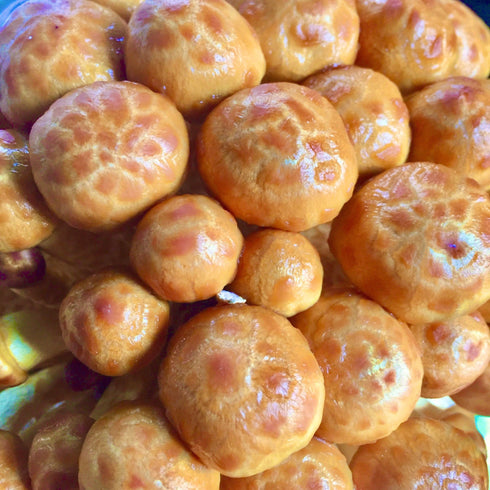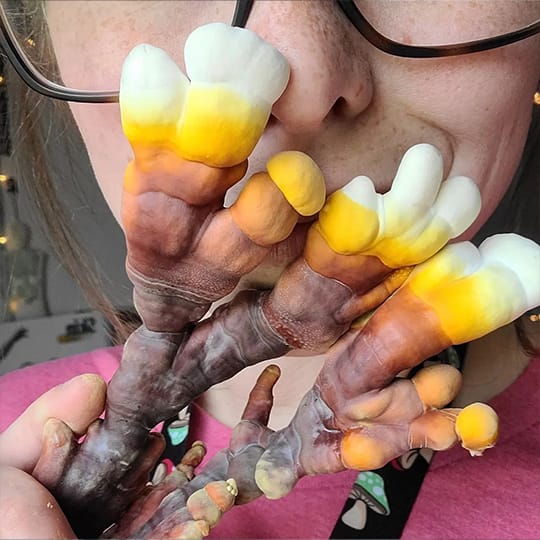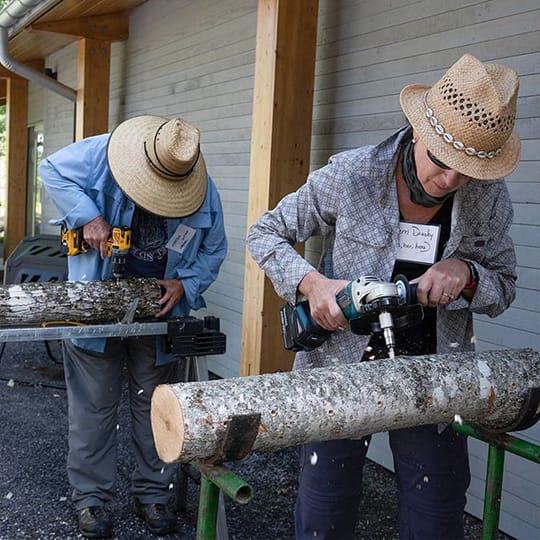











| Skill level | Advanced |
| Grow location | Indoors |
| Grow speed | 2 to 3 weeks |
| Shelf life | 6 months (refrigerated) |
| Kit dimensions | 6in H x 9in W x 6in D |
| Kit weight | 5 lbs |
| Fruiting temps | 45-65°F |
Our nameko (Pholiota nameko) fruiting block features a popular strain widely cultivated in Japan. These kits produce mushrooms that have an earthy flavor with subtle fruit-like hints. And, when cooked, they will fill the air with an aroma that is reminiscent of cashews and butterscotch. As namekos grow, they become covered in a layer of natural gelatin which gives them a unique, almost shiny appearance. In addition to eating the mushroom, their gelatinous covering has a variety of uses and can be made into soups, sauces, or used as a natural thickening agent!
Nameko mushroom kits, though reliable, require extra attention and more time to produce mushrooms. Because they need cooler temperatures and constant humidity when fruiting, they are more difficult to cultivate. They are not ideal for beginners, but can be quite rewarding for experienced growers. Using a humidity tent or humidity-controlled fruiting chamber will help mitigate moisture issues as long as there is proper gas exchange.
"5 of the Best Nameko Mushroom Recipes"
"How to Use a Mushroom Fruiting Block Kit"
Upon receiving your kit:
Remove kit from the shipping box as soon as possible. Then, unfold the top of the bag, making room for air space. It's also important to check and confirm that the filter patch is not obstructed. This will help the organism breathe and continue to thrive until you are ready to grow your fruiting block!
Scroll down for guides on growing, storage, cooking, and more.
-
For the majority of mushroom species, all that is needed to initiate fruiting (or begin the growth cycle) is a change in environmental conditions -- specifically humidity, light, temperature, and changes to oxygen and CO2 levels.
For best results:
We recommend growing your nameko block in a fruiting chamber (like a monotub or martha tent) as a controlled environment will decrease the risk of contamination and increase the chances of success.
Creating optimal conditions:
The environmental parameters for nameko mushrooms can be found on this page under "Temp, Humidity & CO2 guide" and on page 15 of our fruiting block instruction booklet.
How to initiate fruiting:
- Cut off the top of the bag, leaving plastic bag sidewalls approximately 4” taller than the block.
- Using a clean fork, scratch several 1cm deep cuts into the mycelium coating. Don't cut too deeply, as this will result in the mycelia fracturing easily.
- Place back into the fruiting chamber until ready to harvest.
Pro tips:
- Namekos like it cold, below 65°F, throughout pinning and fruiting. If you try to grow at warmer temperatures, you will get small underdeveloped fruiting bodies. To get temps down in your fruiting chamber, fill the bottom of a small, insulated, uncovered box with ice cubes and sit the nameko fruiting block on top. Then place the box back into the fruiting chamber. Replace ice cubes daily.
- Namekos need high humidity during the pinning phase. To get the high humidity required without creating water accumulation in your fruiting chamber, use a spray bottle twice a day to supplement fruiting chamber humidity. By doing this, you won't have to run the humidifier as high.
Special considerations:
- Nameko are sensitive to moisture loss. Be sure the surface is always kept moist or the primordia (pins) will be at risk of aborting.
- Nameko are sensitive to CO2, especially in the pinning phase.
Harvesting your mushrooms:
Harvest namekos before the caps open. Remove entire cluster with care to minimize breaking and then trim away the substrate.
Growing different blocks together:
With some compromise, many different species of mushrooms can be grown together in a fruiting chamber. First, consider the temperature range of the mushrooms you desire to grow, and second, the CO2 sensitivity. Humidity ranges overlap for the majority of species. We encourage you to experiment with many different groupings!
Troubleshooting:
Having issues with unusual growth, stunted growth, or no growth at all? Refer to pages 16-18 in our fruiting block instruction booklet.
-
Temperature 45-65°F | 7-18°C Humidity (Phase 1: Primordia) 98-100% Humidity (Phase 2: Fruitbody) 88-95% CO2 Sensitivity (Phase 1: Primordia) 500-1,000 ppm CO2 Sensitivity (Phase 2: Fruitbody) <1,000 ppm - Primordia - The earliest recognizable stage of fruitbody development. Also known as “baby mushrooms” or “mushroom pins.”
- Fruitbody - A fully grown mushroom, the reproductive structure of the organism in which the spores are produced.
- CO2 sensitivity - When CO2 levels are too high, yields will decrease, stems will become long and stringy, caps will be small, and/or growth will halt.
-
If you don't plan to use immediately, you can refrigerate your block for up to 6 months.
-
Nameko is a lesser known culinary mushroom in the Americas, but it is used widely in East Asia. It has a gelatinous cap that can thicken soups and sauces and an aroma that walks the line of being both fruity and earthy. Nameko mushrooms go well with dark green vegetables, red meats, and shallots, and are used traditionally in Japanese miso soups.
-
If you’re going to consume home-grown mushrooms, make sure to cook your fresh mushrooms thoroughly with heat. If it is your first time eating this species, it is best to start with a small amount to check for allergies, even if cooked.
Mushrooms grow spores as they develop. This is a natural means of reproduction. This is when people with allergies or compromised immune systems may want to consider putting fruiting mushroom kits outdoors or in a well-ventilated area. Spores in mushrooms sometimes cause respiratory irritation. In rare cases, spores may also cause irritation for some non-allergic or non-immunocompromised mushroom growers. If you are one of them, it is recommended to reduce the overall spore load by harvesting mushrooms while they are still in their younger growth stages.
-
You may also like
Making the world of mushrooms accessible to all
North Spore was launched in 2014 by a mycologist, an organic farmer, and a photojournalist -- three college friends brought together through their shared love of the mycological world.
What began as a simple love for mushroom foraging and cultivation quickly developed into an obsession with all things fungi. From there, an urban mushroom farm was born, as was the desire to spread the spore to the masses.
- Reviews
- Questions
Thank you for submitting a review!
Your input is very much appreciated. Share it with your friends so they can enjoy it too!
Fun to try something new!
I have always wanted to try growing namekos, and this kit made it easy. They are definitely tricky, and finding the right level of humidity was a challenge. But I am so glad I tried. And the "goo" was fun, too!
These make a great vegan dashi.
Only got this one to fruit once, but it is a bad time of year here for these cold lovers so it is to be expected. If I can find a place for it in my fridge I may let it rest for awhile in there.













